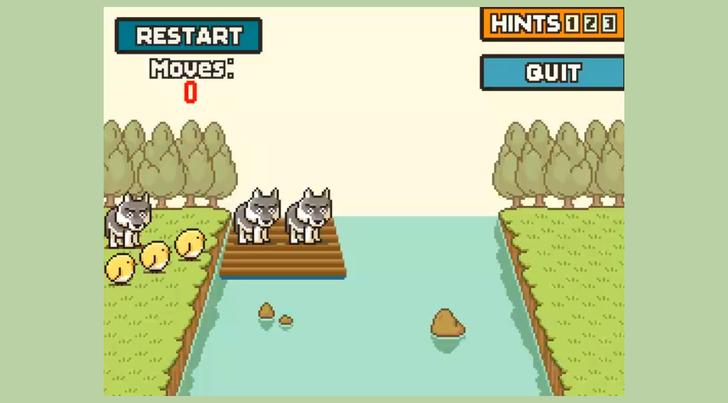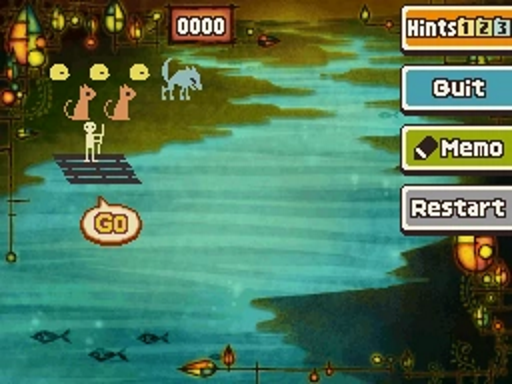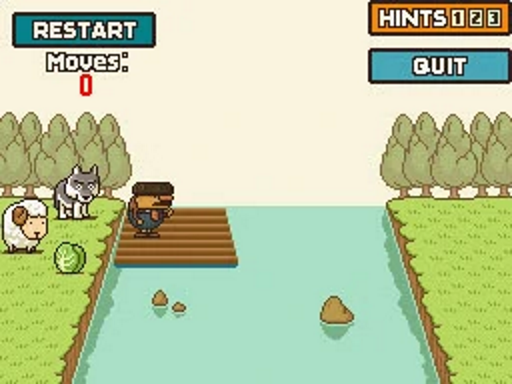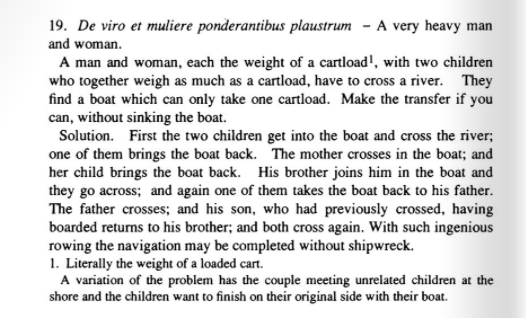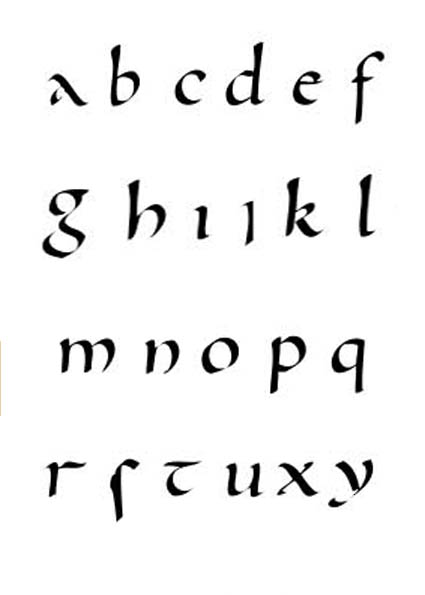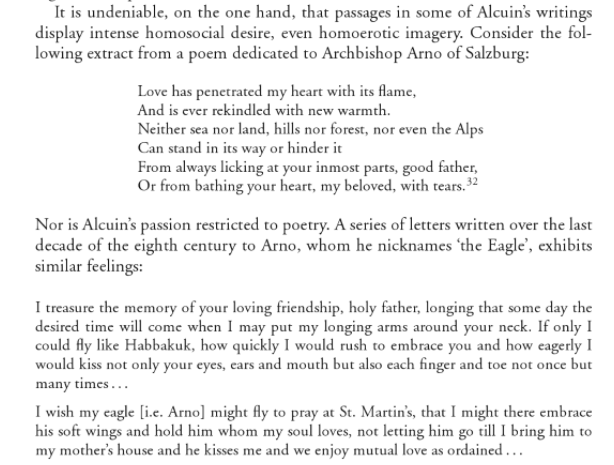So there& #39;s a class of puzzles called "river crossing puzzles" which involve having to cross a river on a boat/bridge containing some set of individuals/items with restrictions on which ones can be on the boat/left on each shore, right?
and the most common subclass of these problems is the one where you have 3 items/animals to cross with.
This is alternatively called the "fox, goose, and bag of beans" or "wolf, goat, and cabbage" puzzle.
This is alternatively called the "fox, goose, and bag of beans" or "wolf, goat, and cabbage" puzzle.
the idea is that your boat can only carry one item at a time, but if you leave the wolf/fox unattended with the goat/goose, the wolf/fox will eat the goat/goose.
and similarly, the goose/goat will eat the beans/cabbage if left alone
and similarly, the goose/goat will eat the beans/cabbage if left alone
so you have to set up a set of actions that never leaves either side of the river in one of the lose-states.
the solution to this variant being:
1. take the goat/goose over
2. return empty
3. take the wolf/fox over
4. return with the goat/goose
5. take the cabbage/beans over
6. return empty
7. take the goat/goose over
1. take the goat/goose over
2. return empty
3. take the wolf/fox over
4. return with the goat/goose
5. take the cabbage/beans over
6. return empty
7. take the goat/goose over
the primary trick being that you have to realize that you can take items BACK, and that& #39;s the only way to solve it.
and there& #39;s a lot of variations on this puzzle, mechanically, like sometimes you can take two items instead of one, and sometimes you can& #39;t make a trip empty, and those affect how the relationships between the items have to work to make the puzzle tricky and/or possible.
but the part that always interests me is that ITEMS themselves have endless variations! as you might guess from the fact this puzzle doesn& #39;t have a single canonical name and I& #39;m using two variations to describe it.
for the simplest variation (1 item, empty trips allowed) you just need any set of items A, B, and C where A can& #39;t be left alone with B, B can& #39;t be left alone with C, and there& #39;s no obvious reason why A would have interest in C.
So it allows for endless creativity.
So it allows for endless creativity.
wikipedia lists some variations:
* wolf, sheep, cabbage
* fox, chicken, grain
* fox, goose, corn
* panther, pig, porridge
* wolf, sheep, cabbage
* fox, chicken, grain
* fox, goose, corn
* panther, pig, porridge
and this puzzle (and the other river-crossing puzzles) dates back to at least the 9th century (that being the earliest example of it that we have), so it& #39;s unsurprising that there& #39;s so many variations.
every storyteller can mix it up as they like
every storyteller can mix it up as they like
like this made it into an episode of the Simpsons!
In "Gone Maggie Gone", Homer has to cross a river with Maggie, Santa& #39;s Little Helper, and Rat Poison That Looks Like Candy.
In "Gone Maggie Gone", Homer has to cross a river with Maggie, Santa& #39;s Little Helper, and Rat Poison That Looks Like Candy.
So my thought with this puzzle has always been to take it to a silly extent, and research all the cosmetic variations (well, as many as I can find), right?
Come up with a big list of items you might need to boat across a river.
Come up with a big list of items you might need to boat across a river.
Then figure out how they might interact, and make a randomized metagame of the A->B->C River Crossing Problem.
Either just the 3 item, 1 storage, empties allowed version, or expand it to more items by allowing more storage and varying empties.
Either just the 3 item, 1 storage, empties allowed version, or expand it to more items by allowing more storage and varying empties.
but the main amusing bit is that some challenges might be trivial or impossible, depending on which ones you are given.
Like you might have a puzzle where you& #39;re a farmer who has
1. a bag of beans
2. a cabbage
3. a panther
and needs to cross the river
Like you might have a puzzle where you& #39;re a farmer who has
1. a bag of beans
2. a cabbage
3. a panther
and needs to cross the river
well, that one is easy.
beans aren& #39;t going to eat cabbage, cabbage isn& #39;t going to eat beans, and panthers are carnivores who aren& #39;t going to care about beans & cabbages
beans aren& #39;t going to eat cabbage, cabbage isn& #39;t going to eat beans, and panthers are carnivores who aren& #39;t going to care about beans & cabbages
and you could even build this as a sort of community-sourced system, letting people introduce new items by figuring out their relationships to categories of items.
so you could define items as having tags applying to them, then define relationships between tags.
So, like, you could define [predator] as a tag, and it applies to wolves, foxes, and panthers.
Then you define other items (goats, chickens, geese) as [prey animals]
So, like, you could define [predator] as a tag, and it applies to wolves, foxes, and panthers.
Then you define other items (goats, chickens, geese) as [prey animals]
and then you just define the rule as:
you can& #39;t leave a [predator] and a [prey animal] on the same shore unattended.
you can& #39;t leave a [predator] and a [prey animal] on the same shore unattended.
so then a user could submit a new item: Lion.
Lion is a [predator].
Now you automatically get functionality for the lion, without having to define how lions feel around chickens, geese, and goats.
Lion is a [predator].
Now you automatically get functionality for the lion, without having to define how lions feel around chickens, geese, and goats.
the fun part of this sort of database game is that it means you can find all the various versions that were implemented in different games and described in stories, and then emulate them in the ABC-river-crossing-puzzle metagame.
with proper tagging you could figure out how to emulate the Maggie, Santa& #39;s Little Helper, and Rat Poison That Looks Like Candy puzzle.
anyway, the "randomized metagame of A>B>C river crossing" is the point I wanted to get to with this thread.
but I just found a mistake in wikipedia. Sigh.
but I just found a mistake in wikipedia. Sigh.
OKAY SO remember how I said this is ONE OF the river crossing problems? There are others, which are closely related.
So another two are the "Missionaries and cannibals" puzzle and the "jealous husbands" puzzle.
With the missionaries and cannibals puzzle, you have six items and a 2-capacity boat that cannot move while empty.
The six items are:
3 cannibals
3 missionaries
The six items are:
3 cannibals
3 missionaries
and in this case the "cannot be left alone" logic is different:
it& #39;s instead "cannot be outnumbered".
So cannibals will eat missionaries if at any point there& #39;s more cannibals than missionaries on a given shore.
it& #39;s instead "cannot be outnumbered".
So cannibals will eat missionaries if at any point there& #39;s more cannibals than missionaries on a given shore.
So similarly to the A>B>C puzzle, you have to take items back across to make it work. The solution is a little longer (so I wouldn& #39;t include it here) but not fundamentally more complicated.
The Jealous Husbands is a close variation of the Missionaries and Cannibals puzzle but it adds a relationship between the items:
You have three married couples, and no wife can be left alone with another husband unless her husband is also present
You have three married couples, and no wife can be left alone with another husband unless her husband is also present
so now you have to worry about which items are moving across and which ones they& #39;re being left with, instead of just how many of each type you have.
so, why is wikipedia WRONG?
well, you can see that both the "Missionaries & Cannibals" and "Jealous Husbands" puzzles are not the same, mechanically, as the Fox/Goose/Beans-style A>B>C puzzle, right?
well, you can see that both the "Missionaries & Cannibals" and "Jealous Husbands" puzzles are not the same, mechanically, as the Fox/Goose/Beans-style A>B>C puzzle, right?
well, on the page for A>B>C puzzles they mention some game and shows that include examples of it, and they mention Professor Layton and the Curious Village as having an A>B>C puzzle in it.
Makes sense, that game is an adventure game of puzzle minigames, of course they& #39;d use it!
Makes sense, that game is an adventure game of puzzle minigames, of course they& #39;d use it!
well let& #39;s look up what 3 items it used. lemme check gamefaqs or whatever...
To make things more confusing, in Professor Layton and the Last Specter, the 4th game in the series, they did another river crossing puzzle.
What kind is this one? ehhh...
What kind is this one? ehhh...
You have one dog, two cats, and three baby chicks.
The dog can& #39;t be left with only one cat, and you have to have more chicks than cats.
The raft holds two animals
The dog can& #39;t be left with only one cat, and you have to have more chicks than cats.
The raft holds two animals
So it seems they tried to combine a bit of A>B>C with some Missionaries and Cannibals.
Fundamentally I think it& #39;s mostly a Missionaries & Cannibals puzzle, they just expanded it to 3 groups and varied how many items there were in each group (1,2,3 instead of 3,3).
ANYWAY now I gotta figure out if there was more than one river-crossing puzzle in Professor Layton and the Curious Village, and then if not, fix wikipedia.
GOOD NEWS EVERYONE!
There IS another river crossing puzzle ( #93) in Curious Village.
It& #39;s an A>B>C puzzle, using a Wolf, Sheep, & Cabbage.
There IS another river crossing puzzle ( #93) in Curious Village.
It& #39;s an A>B>C puzzle, using a Wolf, Sheep, & Cabbage.
although now I have a mistake in the Professor Layton wiki to fix, since they have a category for "River" puzzles, and that category has the two from Curious Village but not the one from Last Specter.
anyway an interesting thought experiment would be to figure out a way to devise a single system that can encompass all three puzzle variations:
A>B>C, Missionaries & Cannibals, and Jealous Husbands.
A>B>C, Missionaries & Cannibals, and Jealous Husbands.
For completeness, another sort of river crossing puzzle is the Bridge & Torch puzzle:
You have four people who need to cross a bridge over a dangerous river. It& #39;s dark and if they don& #39;t have a torch, they& #39;ll fall off and drown.
The torch will burn out in 15 minutes.
You have four people who need to cross a bridge over a dangerous river. It& #39;s dark and if they don& #39;t have a torch, they& #39;ll fall off and drown.
The torch will burn out in 15 minutes.
The four people walk at different speeds:
They can cross it in 1 minute, 2 minutes, 5 minutes, and 8 minutes.
If two people cross together, they have to move at the speed of the slower person.
They can cross it in 1 minute, 2 minutes, 5 minutes, and 8 minutes.
If two people cross together, they have to move at the speed of the slower person.
The bridge will collapse if more than 2 people are on it at once, so they can& #39;t just all go at once.
So how do you get all 4 people across?
So how do you get all 4 people across?
and naturally this puzzle can have the numbers varied to allow for sloppier solutions which& #39;ll make it easier.
And you can cosmetically change it up while leaving it mechanically identical.
And you can cosmetically change it up while leaving it mechanically identical.
this one is way more recent than the other three.
Those versions are 1200 years old, this one is known to be at least... 39 years old.
Those versions are 1200 years old, this one is known to be at least... 39 years old.
since the others are from the 8th century and this one is from the 80s.
anyway, the solution is, if A=1m, B=2m, C=5m, D=8min:
* A,B cross, taking 2 minutes
* A returns, 1 minute
* C,D cross, taking 8 minutes
* B returns, taking 2 minutes
* A,B cross, taking 2 minutes
2+1+8+2+2: 15 minutes
* A,B cross, taking 2 minutes
* A returns, 1 minute
* C,D cross, taking 8 minutes
* B returns, taking 2 minutes
* A,B cross, taking 2 minutes
2+1+8+2+2: 15 minutes
The interesting variations in this puzzle is that it puts the problem in the time domain, which is harder to reason about for most people (or at least me: I have ADHD, I don& #39;t know what the fuck a time is)
and also you have to alternate trips, because the torch has to move.
and also you have to alternate trips, because the torch has to move.
so you can& #39;t just send D across, then C across, then B across, then A across.
Because the torch has to return, and also that& #39;d take too long (8+5+2+1)
Because the torch has to return, and also that& #39;d take too long (8+5+2+1)
Another variation (which I don& #39;t see as much analysis of) comes from the same manuscript as the jealous husbands and A>B>C puzzles: it was called "Propositio de viro et muliere ponderantibus plaustrum", which means something like "the puzzle of the weights of a man & woman "
in this version, you have a man, a woman, and two children to cross a river: the adults weigh "a cartload", and the children weigh half a cartload.
If more than a cartload is loaded into the boat, it sinks.
If more than a cartload is loaded into the boat, it sinks.
The solution: Parents are A/B, kids are C/D:
* CD cross
* C comes back
* A crosses
* D comes back
* CD cross
* C crosses back
* B crosses
* D crosses back
* CD cross
* CD cross
* C comes back
* A crosses
* D comes back
* CD cross
* C crosses back
* B crosses
* D crosses back
* CD cross
basically the reason this is a puzzle instead of simple or impossible is that you can& #39;t move the boat empty, and you can fit both kids in the boat.
if the boat could move empty, it& #39;d be simple. A crosses, boat returns empty, B crosses, etc.
if the boat could move empty, it& #39;d be simple. A crosses, boat returns empty, B crosses, etc.
and if you couldn& #39;t stuff both kids in the boat, you wouldn& #39;t be able to do it, because you& #39;d have to bring back 1 person for every 1 you moved over
anyway this version from The Mathematical Gazette translates the title as "a very heavy man and woman" which may be more accurate, my latin isn& #39;t great.
Don& #39;t fatshame, 9th century-unknown-guy (possibly Alcuin of York)
Don& #39;t fatshame, 9th century-unknown-guy (possibly Alcuin of York)
Alcuin was this guy, born in the 730s, who was a scholar & teacher at the court of Charlemagne. He was heavily involved in popularizing Carolingian minuscule, a script which helped make Latin scripts readable across different regions.
he got a lot of older manuscripts copied into this new script, which helped spread it across Europe, but it also helped preserve a lot of manuscripts, because now new copies were made and in many cases the newer ones survived and the originals have not.
The reason he& #39;s suspected by some to be the author of the text on river crossing puzzles is that he wrote a latter in 799 to Charlemagne saying he sent "certain figures of arithmetic for the joy of cleverness".
and that& #39;s suspected to be the manuscript Propositiones ad Acuendos Juvenes (Problems to Sharpen the Young), which dates to about the same time.
That manuscript is 53-56 (depending on edition) puzzles, and it& #39;s the oldest version of the river-crossing puzzle we know.
That manuscript is 53-56 (depending on edition) puzzles, and it& #39;s the oldest version of the river-crossing puzzle we know.
specifically it contains the jealous husbands problem, the A>B>C puzzle, and the heavy-people-in-the-boat puzzle.
the missionaries & cannibals variant is from the late 19th century, and as mentioned before, the torch-timing puzzle is from the 80s.
anyway a final fun fact about Alcuin is that some historians have argued he was gay.
John Boswell called his writing "a personal outpouring of internalized homosexual feelings"
John Boswell called his writing "a personal outpouring of internalized homosexual feelings"
and David Clark, in his book "Between Medieval Men: Male Friendship and Desire in Early Medieval English" argued that the way he& #39;s written about his love for other men goes beyond love between friends:
So while it& #39;s of course debatable I& #39;m just gonna add him to my personal-gay-heroes list, given his incredible influence.
no one can ever imagine that I would admire a historical person who was influential in typography and gaming, and I literally named myself after a historical gay mathematician...

 Read on Twitter
Read on Twitter